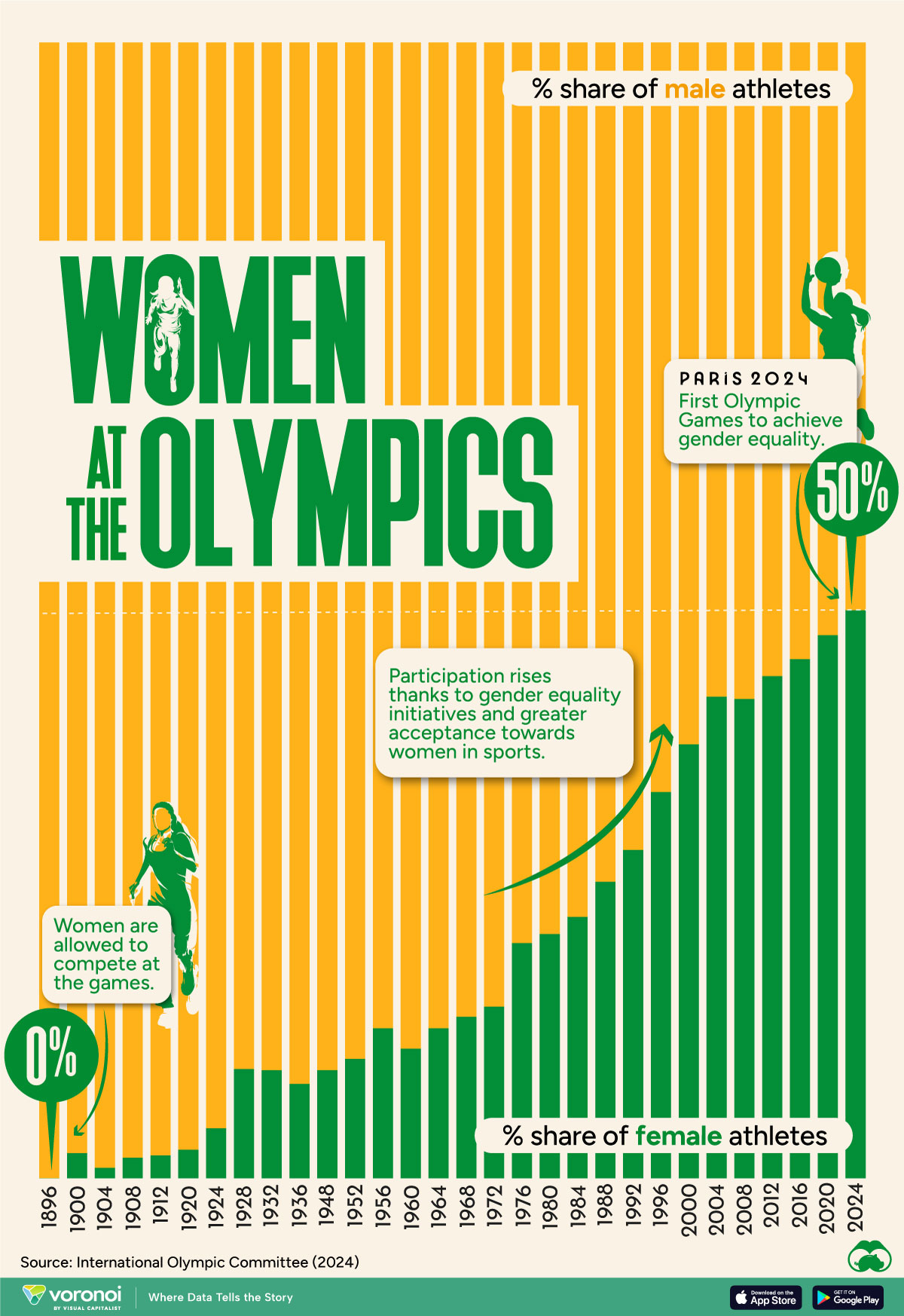![]()
See this visualization first on the Voronoi app.

Use This Visualization
Charted: Percentage of Women Competing at the Olympic Games (1896–2024)
This was originally posted on our Voronoi app. Download the app for free on iOS or Android and discover incredible data-driven charts from a variety of trusted sources.
For the first time ever, an Olympic Games has achieved gender equality. Half of all competing athletes at Paris 2024 are women. But how did we get here?
This chart tracks the share of male and female athletes participating through the Olympic Games over the years. Data is sourced from the International Olympic Committee (IOC) as of 2024.
The Long Road to Olympic Equality
Paris 2024’s achievement comes more than a century after women were first allowed to participate in the games, as it happens, in Paris 1900.
| Summer Olympic Games | % Share of Female Athletes | % Share of Male Athletes |
|---|---|---|
| 1896 | 0 | 100 |
| 1900 | 2 | 98 |
| 1904 | 1 | 99 |
| 1908 | 2 | 98 |
| 1912 | 2 | 98 |
| 1920 | 3 | 98 |
| 1924 | 4 | 96 |
| 1928 | 10 | 90 |
| 1932 | 10 | 91 |
| 1936 | 8 | 92 |
| 1948 | 10 | 91 |
| 1952 | 11 | 90 |
| 1956 | 13 | 87 |
| 1960 | 11 | 89 |
| 1964 | 13 | 87 |
| 1968 | 14 | 86 |
| 1972 | 15 | 85 |
| 1976 | 21 | 79 |
| 1980 | 22 | 79 |
| 1984 | 23 | 77 |
| 1988 | 26 | 74 |
| 1992 | 29 | 71 |
| 1996 | 34 | 66 |
| 2000 | 38 | 62 |
| 2004 | 42 | 58 |
| 2008 | 42 | 58 |
| 2012 | 44 | 56 |
| 2016 | 46 | 54 |
| 2020 | 48 | 52 |
| 2024 | 50 | 50 |
Note: Figures rounded.
Back then, only 22 women took part in five sports: tennis, sailing, croquet, equestrian, and golf. They represented roughly 2% of the entire competition. Hélène de Pourtalès, a sailor representing Switzerland, became the first woman Olympic champion.
Since then women’s participation has ticked up slowly. It took until halfway through the 20th century to reach 10%, and then another three decades to cross 20%.
However, in the last four decades especially, the IOC has made a concerted effort to boost women’s participation. In 1976 for example, women were allowed to compete in three new sports: basketball, handball, and rowing. And then in 1991, the IOC mandated that new sports introduced to the Games had to have at least one event for women.
Aside from opening up eligibilities, the IOC also set quotas for National Olympic Committees to meet, and created mixed-gender events.
Beyond just the competition however, women are still underrepresented on the coaching and refereeing side. For example only five sports (tennis, triathlon, canoeing, sailing, and hockey) have achieved gender parity in their judges.
More Olympic Facts From Visual Capitalist
If you enjoyed this article check out Visualizing the Cost of Hosting the Olympics which traces how much countries spent on the event, all the way from the 1996 Atlanta Olympics.
The post Charted: Percentage of Women Competing at the Olympic Games (1896–2024) appeared first on Visual Capitalist.